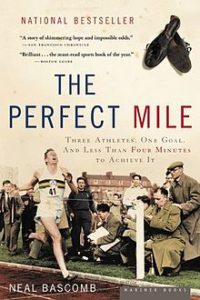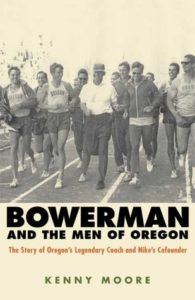The thought hit me sometime during the backstretch of the men’s 1,500 meter final at the Pac-12 Championships last Sunday at Husky Track, as Washington’s Izaic Yorks began to inexorably pull away from the rest of a world-class field of middle-distance runners, his legs churning, the afro atop his head resting impossibly still, the murmur that had pulsed through the crowd for the opening three laps starting to approach a roar. The thought being this: Why on earth isn’t this sport more popular?
It used to be. During the first half of the twentieth century (and again for a brief resurgence during the 1970s), track and field was among the country’s most popular pastimes — right up there with boxing, horse racing and baseball, to give you an idea of how much things change. For a brief moment in time during the early 1950s, it even surged to the forefront of the global sporting consciousness, buoyed by one event in particular that captured the world’s imagination: the mile. And three men in particular were responsible for that race’s rapid rise.
Those men were England’s Roger Bannister, Australia’s John Landy and America’s Wes Santee, the three milers who during 1953 and 1954 dueled to determine who would be the first human being in the millennia of our existence to cover 5,280 feet of ground on foot in fewer than four minutes. They were front-page fixtures and national heroes. Their chase is the subject of Neal Bascomb’s excellent 2004 book “The Perfect Mile,” a rip-roaring chronicle of the three men’s disparate backgrounds, their chase of the four-minute barrier, and Bannister’s ultimate triumph. It’s the sort of book that makes you want to go find a track and run as fast as you can. It was one of the two recent reads that sent me down this rabbit hole.

The other was “Bowerman and the Men of Oregon,” the definitive account of the birth of a track-and-field juggernaut at the University of Oregon written by Kenny Moore, a former Olympic marathoner who ran at UO under the legendary Bill Bowerman. That ideal match of author and subject makes for an enthralling 400 pages, ranging from Bowerman’s service in an elite mountaineering branch of the U.S. Army during World War II to Steve Prefontaine’s thunderous impact in Eugene to Bowerman’s role as a co-founder of Nike.
The best parts, though, are the ones about the acts of running and throwing, the passages where Moore encapsulates the beauty of our purest acts of athletic expression. Like, for instance, here, where he turns the motion of throwing a javelin into longform poetry:
“The javelin is not thrown for meat; it’s thrown for distance. To do that, it must become an airfoil. To do that, it must be fired through a tiny hole in space with graceful surety. If the shaft vibrates, it’s been compromised. If it goes a few degrees too high, it will stall, sicken, and drop, scattering officials. But if all the force of the run can be made to flow through the planting of the opposite leg, through the twisting hips and turning trunk and gathering, waiting, waiting shoulder, and final snapping arm in a straight line, and if that line bears the proper relation to the horizon, then all the transferred energy will be revealed in soaring fight. By the time the javelin’s point stabs the turf, the crowd will have risen up and borne it along on astounded breath.”
Dude can write.

Bowerman’s life was so diverse and interesting that the book nearly glosses over his bedrock role in improving the health of millions of Americans. On a trip to New Zealand to visit fellow coach Arthur Lydiard, Bowerman was exposed to what at the time was a unique phenomenon: jogging. He brought the fad back to Eugene and, before long, had launched the American running boom. An explosion in participation (and, perhaps not incidentally, Nike sales) followed. But an increased interest in competitive track and field as a spectator sport did not. More runners did not equate to more running fans. Minus the every-four-years obsession with the latest winner of the Olympic 100 meter dash, track has essentially been a tertiary sport in the U.S. for the past half century.
Which brings us back to the original question. Why isn’t track and field more popular? I think there are a number of answers. One is television. Track and field, particularly long races and the throws, doesn’t translate nearly as well to the screen as do football or basketball, the two sports whose popularity increased exponentially during the TV age. Another is the absence of notable milestones. When track was at its peak during the middle of the 20th century, the four-minute mile, the ten-second 100 meters, and the twenty-second 200 meters were almost inconceivable limits being chased by what seemed a species of superheroes. Once those barriers fell, perhaps it was human nature for interest to wane. A third possible reason is simple ignorance. Writing from personal experience, some events can be tough to appreciate without some level of expertise. While the 100 is viscerally thrilling, enjoying a well-executed throw of the discus acquires slightly more nuance.
There are counters to all those answers, however. With massively improved, inexpensive portable cameras, it should be easier than ever before to show races on TV in an entertaining way. While the shorter-distance milestones may have gone by the wayside, there are certainly still notable record chases underway — namely the race to break two hours in the marathon, as recently analyzed by The New York Times. And a lack of knowledge about the sport certainly doesn’t stop neophytes from enjoying football, a game with enough minutiae and jargon to frustrate even the most ardent student.
Beauty is in the eye of the beholder. Maybe I’m in the vast minority here; maybe people just don’t like the sport. But there’s something special about track and field, something that separates it from just about every other athletic pursuit. Instead of competing against other individuals or teams under some arbitrary rules, track is quite literally about pushing the physical limits of what the human race can do. There’s something spiritual there, something true. Bowerman knew it. He was the coach of the U.S. team at the 1972 Olympics in Munich, when a group of Palestinian terrorists horrifically kidnapped and eventually murdered 11 members of the Israeli team. In the aftermath, Moore writes about the case Bowerman made for why the Games must continue.
“From 776 BC to 393 AD, Olympians laid down their arms to take part in the Games. This is no party. This is the species’ great moral advance. This is our answer to war.”
Or as Moore puts it: “There is more honor in outrunning a man than killing him.”
Which brings us back to where we began, at the Pac-12 Championships last weekend, with Izaic Yorks swallowing up yards of synthetic track with every step. The senior from Lakewood, Wash., went on to win the 1500 in 3:39.14 — on pace for a 3:56.61 mile, to give you an idea of how far we humans have come since Roger Bannister first broke four minutes. His was among the weekend’s more superhuman performances. Up there too was Stanford freshman Mackenzie Little, an Australian who uncorked a throw of 176-02 in the javelin to blow away the rest of the competition by thirty feet, a startling margin. So was Oregon’s Devon Allen, who swept the 100, 200 and 110 hurdles; on Saturday, he won his 110 hurdles prelim in 13.32 seconds, the fastest time this year in the U.S. All three may be headed to the Olympics.
Maybe there weren’t that many people watching them run, throw, and soar, and maybe there never will be again. The Pac-12 Network didn’t even broadcast the meet, which is kind of a stunning fact when you consider its sole reason for existence is to televise Pac-12 sports. That’s too bad. Because it’s a rare thing indeed to see our best traits so clearly personified, to see the human machine operating at peak capacity, to see mind and body push one another to discover the limits of possibility one lonesome stride at a time.